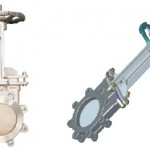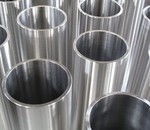 All valves are designed to stop, allow or throttle the flow of a process fluid. Gate valves, one of the original valve designs, are ideally suited for on/off, primarily liquid, service.
All valves are designed to stop, allow or throttle the flow of a process fluid. Gate valves, one of the original valve designs, are ideally suited for on/off, primarily liquid, service.
A gate valve functions by lifting a rectangular or circular gate out of the path of the fluid. When the valve is fully open, gate valves are full bore, meaning there is nothing to obstruct the flow because the gate and pipeline diameter have the same opening. This bore diameter also determines the valve size. An advantage of this full-bore design is very low friction loss, which saves energy and reduces total cost of ownership.
Gate & Segment
There are four primary designs for gate valves – a slab gate, an expanding gate, a wedge valve and a knife gate valve.
- Slab gate valves are comprised of a single gate unit which raises and lowers between two seat rings and are primarily used for transporting crude oil and NGLs. The Cameron GROVE G4N fabricated gate valve and WKM Saf-T-Seal gate valve are ideal choices for this application.
- Unlike a slab gate valve that only has one unit, an expanding gate valve includes two units – a gate and segment. The gate and segment units collapse against each other for travel, and separate when the valve is fully opened or fully closed, to affect a mechanical seal.
- Wedge gate valves are comprised of a tapered gate that is metal-to-metal sealing. In contrast to a slab gate valve or an expanding gate valve, wedge gate valves are not piggable because of the void that is left in the bottom of the valve body when the valve is open. These valves do not have a bore through the gate itself – instead, the gate retracts into the valve body when open – which saves height space that is necessary for slab and expanding gate valves.
- A knife gate valve is used to cut through extremely thick fluids and dry bulk solids. The design of this valve makes it inherently self-cleaning, as the knife is cleared of abrasives with each stroke as it passes the seat rings and skirts. The gate unit of this type of valve is thin compared to other gate valve types and is guided in place by the water-type body that sandwiches the gate.
Stem
Gate valves can have either a rising or non-rising stem design. Rising stems are attached directly to the gate and provide a visual indicator of the valve position. Non-rising stems are generally threaded into the upper part of the gate and have a pointer threaded onto the top to indicate position. Non-rising stem designs are ideally suited for applications where vertical space is limited, in well applications and where scraping/pigging is not required.
Gate valves are designed with a sealing unit to provide a tight seal around the stem. Our unique Single Loaded Spring (SLS) stem seal design, used exclusively on WKM Saf-T-Seal and Pow-R-Seal gate valves, provides superior leak protection and a self-adjusting seal designed to reduce maintenance.
Bonnets
Gate valves generally have one of four types of bonnets, which provide closure from leaks for the body of the valve. Screw-in bonnets are simple, durable sealing units that use pressure to affect a seal. Union bonnets provide easy access to the valve body for applications that may require frequent maintenance or inspection. Bolted bonnets are generally used for larger valves in higher pressure applications. Finally, pressure seal bonnets are designed for services with high pressure in excess of 15MPa (2250 psi).
Applications
Because of the diversity of construction materials, trim offerings, and design combinations available with gate valves, they are appropriate for use in a wide variety of applications. From high-temperature coking units to food and pharmaceutical services, gate valves can be trusted to reliably perform.
The protected seat face design of double expanding and slab gate valves eliminates degradation of the seat face caused by debris in the process fluid, which makes them ideal for liquid service. When additional protection is needed at points in pipeline applications where operational integrity is vital and the consequences of environmental exposure are higher, such as near waterways and municipalities, double- expanding gate valves are a particularly wise choice.
Our smaller 2” to 4” non-rising stem version of the WKM Pow-R-Seal Model M is commonly utilized in wellhead manifold systems because of its reliable mechanical seal and high pressure capability.
Certain gate valves also can be designed easily into drilling manifold systems, like the Cameron DEMCO DM series, with space saving and versatile mounting designs.
In the power industry, NEWCO and DOUGLAS CHERO gate valves are ideal for standard and critical applications, such as steam distribution in power plants. By replacing the body and bonnet flanges with a welded connection, the design of this valve eliminates a leak path, reduces weight and simplifies the application of exterior insulation. This, in concert with the forged steel body, provides the highest integrity sealing available.
For the challenging subsea environment where pressures are extremely high, temperatures are low and operation is difficult, subsea manifolds that integrate valves and interface panels are used for critical isolation. The simple design of the Cameron RING-O slab gate valve is ideally suited for integration into these systems and can be manually, ROV or hydraulically actuated for ease of operation.
We made a variety of valves. If you are interested in these parts, you can feel free to contact us.
Sourced by ekomeri





